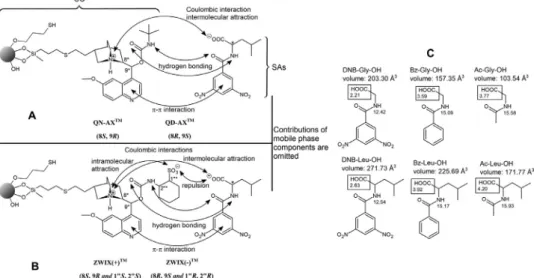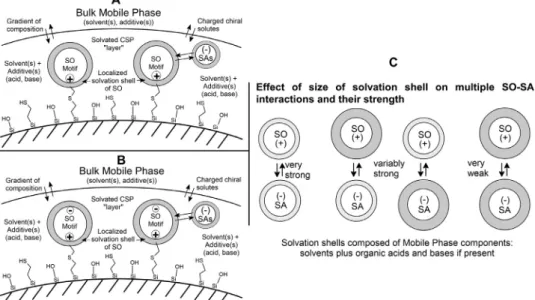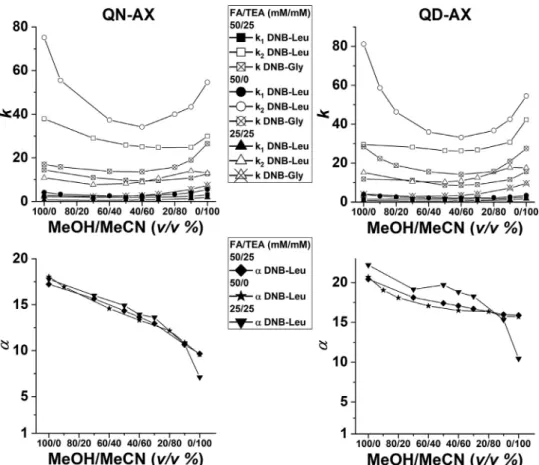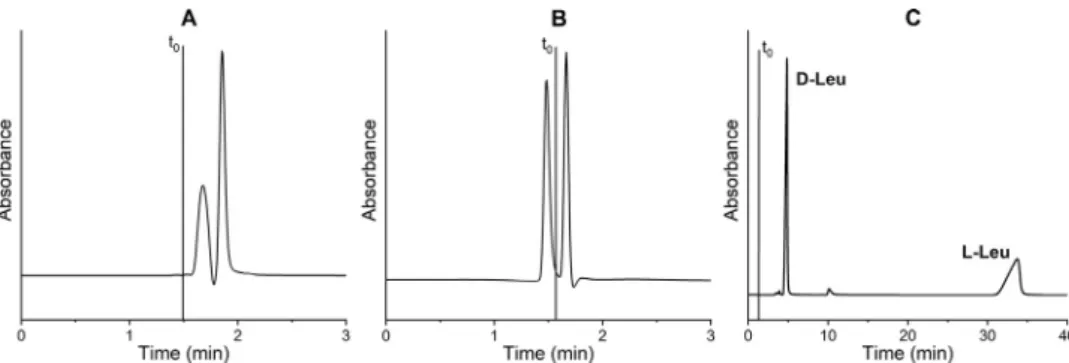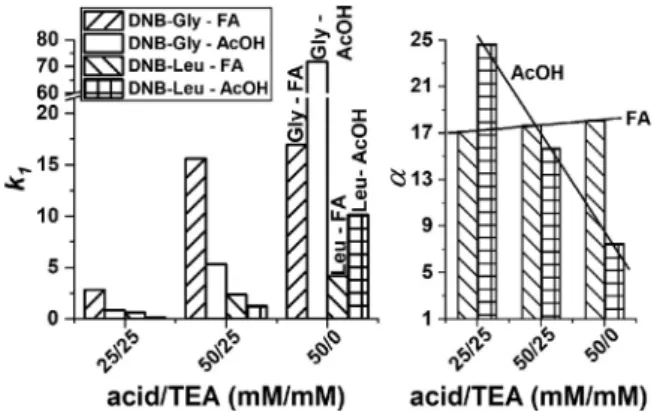ContentslistsavailableatScienceDirect
Journal of Chromatography A
journalhomepage:www.elsevier.com/locate/chroma
Unexpected effects of mobile phase solvents and additives on retention and resolution of N -acyl-D,L-leucine applying
Cinchonane -based chiral ion exchangers
Dániel Tanács
a, Tímea Orosz
a, István Ilisz
a,∗, Antal Péter
a, Wolfgang Lindner
b,∗aInstitute of Pharmaceutical Analysis, Interdisciplinary Excellence Centre, University of Szeged, H-6720 Szeged, Somogyi u. 4, Hungary
bDepartment of Analytical Chemistry, University of Vienna, Währinger Strasse 38, 1090 Vienna, Austria
a rt i c l e i nf o
Article history:
Received 27 February 2021 Revised 22 April 2021 Accepted 25 April 2021 Available online 1 May 2021 Keywords:
High-performance liquid chromatography Cinchona alkaloid-based weak
anion-exchangers and zwitterionic chiral stationary phases
αapparentand enantiomer separations, Solvent and additives effects
a b s t r a c t
Chiralionexchangersbasedonquinine(QN)andquinidine(QD),namelyChiralpakQN-AXandQD-AXas anionicandZWIX(+)andZWIX(-)aszwitterionicionexchangerchiralstationaryphases(CSPs)havebeen investigatedwithrespecttotheirretentionandchiralresolutioncharacteristics.Fortheevaluationofthe effectsofthecompositionofthepolarorganicbulksolventsofthemobilephase(MP)andthoseofthe organicacidandbaseadditivesactingasdisplacersnecessaryforaliquidchromatographicion-exchange process,racemic N-(3,5-dinitrobenzoyl)leucine and otherrelatedanalytes wereapplied.The mainaim wastoevaluatetheimpactoftheMPvariationsontheobserved,andthustheapparentenantioselectivity (αapp), and the retentionfactor.Significant differences werefoundusing either polarprotic methanol (MeOH)orpolarnon-proticacetonitrile(MeCN)solventsincombinationwiththeacidandbaseadditives ascounter-andco-ions.Itbecameclear,thatthechargedsitesofboththechiralselectorsoftheCSPs andtheanalytesgetspecificallysolvated,accompaniedbytheadsorptionofallMPcomponentsonthe CSP,therebybuildingastagnant“stationaryphaselayer” withacompositiondifferentfromthebulkMP.
ViaasystematicchangeoftheMPcomposition,trendsofresultingαappandretentionfactorshavebeen identifiedanddiscussed.
Inadetailedsetofexperiments,theeffectoftheconcentrationoftheacidcomponentintheMPcon- tainingMeOHorMeCNwasspecificallyinvestigated,withtheacidconsideredtobeadisplacerinanion- exchangetypechromatographicsystems.
Surprisingly,allfourchiralcolumnsretainedandresolvedthetestedN-acyl-Leuanalyteswithαappvalues upto21withinaretentionfactorwindowof0.03and 10withpureMeOH aseluent.However, using pureMeCNaseluent,analmostinfinite-longretentionoftheacidicanalytewasnoticedinallcases.We suggestthattheratherdifferentthicknessofthesolvationshellsgeneratedbyMeOH orMeCNaround thecharged/chargeablesitesofthechiralselectordetermineseventuallythestrengthoftheelectrostatic selector–selectandinteractions.
As acontrol experiment we included the non-chiral N-acylglycine derivatives as analyte inall cases to support the interpretations with respect to the contribution of the enantioselective and non- enantioselectiveretentionfactorincrementsasapartoftheobservedαapp.
© 2021 The Author(s). Published by Elsevier B.V.
ThisisanopenaccessarticleundertheCCBYlicense(http://creativecommons.org/licenses/by/4.0/)
1. Introduction
Various liquid chromatographic enantiomer and diastereomer separation concepts have reached a high analytical and prepara- tive standard over the years as exemplifiedby diversededicated
∗Corresponding authors.
E-mail addresses: ilisz.istvan@szte.hu (I. Ilisz), wolfgang.lindner@univie.ac.at (W.
Lindner).
reviewarticles[1–9].Besidethefocusonrelevantapplications,in- vestigationsandinterpretationsrelatedtotheunderlyingenantios- electivemolecularrecognitionmechanismsandadsorptionmodels havealsobeenundertakenanddescribedindetail[10–13].
Ageneralized view,wherethe enantiomer resolutionis based on the formation of intermediate molecule associates between thechiral selector(SO)moietyandtheindividual enantiomers of the chiral analytes, the selectands [(R)-SA and (S)-SA] does not pay the necessary attention to the actual situation of a wetted
https://doi.org/10.1016/j.chroma.2021.462212
0021-9673/© 2021 The Author(s). Published by Elsevier B.V. This is an open access article under the CC BY license ( http://creativecommons.org/licenses/by/4.0/ )
chiral stationaryphase(CSP), wherethechemically modifiedsur- faceofthesilicaparticlesisnotfullyhomogenous.Whatweactu- allyobserveasachromatogramistheresultofalloccurringstere- ospecificandnon-stereospecificinteractionsofSO–SAmoleculeas- sociates, and additional interactions of SA with the imperfectly derivatizedandwettedsilicasurface,including,e.g.,theremaining freesilanolgroups.Inadditiontotheseconsiderations,theconfor- mational flexibilityofthechiralmotifaroundthebinding sitesof the SOmoietyhas tobe takeninto considerationwhich,in turn, will dependon thesolventenvironment ofthewettedCSP being inequilibriumwithallcomponentsoftheMP.
Theobserved(apparent)retentionfactorkappofeachindividual enantiomer(R)-SA(1)and(S)-SA(2)isthesumofenantioselective (es)andnon-enantioselective(ns) adsorption phenomena(includ- ing partition, when applicable), which can largely differ in their magnitude [14–16]. The apparent retention factors can be writ- ten as kapp1 = kes1 + kns1 for the first-eluting enantiomer and kapp2 =kes2 + kns2 forthesecond-eluting enantiomer ofachiral analyte,wherethenonselectiveretentionfactors(kns1andkns2)are identical.
Theapparentenantioselectivityfactor
α
appistherefore:∝app=kapp2
kapp1 (1)
Inliquidchromatographyanintegralpartoftheobservedphe- nomena relates to the chemical structure of the SO motif, in- cluding all the functional groups capable for hydrogen bonding, electrostatic interaction,etc.,anditsconformational flexibilityand thustothesolvatedCSP,whichisdirectlyassociatedwithallmo- bile phase components andtheir physico-chemical characteristics [17,18].TheSO–SAinteractionsencompassessentiallyelectrostatic, hydrogen bonding,
π
–π
andvander Waals (hydrophobic) forces, whicharequitedifferentintheirmagnitude. Ina simplifiedview, solvents act as quasi competitors (displacers) to the overall ac- tive SO–(R)-SA andSO–(S)-SA interactions. Asa consequence,the liquid-chromatographic process can be formulated by a stepwise adsorption, desorption, and elution ofthe solvatedanalytes from thesolvatedCSP.First,thereisade-solvationeventoftheindivid- ually solvated molecular entities (SO andSAs) duringthe forma- tion ofthe two SO–(R)-SA andSO–(S)-SA associatesaccompanied by theirsolvation,followedbyare-solvationoftheindividualen- tities(theSOandtheSAs)asaconsequenceofthedissociationof the diastereomeric associates. The chemical characteristics ofthe SOandSAaswellasthetypeofsolvents,acids,bases,saltsorneu-traladditivesandtheircomposition intheMPmayplayasignifi- cantroleinbuildingupanenvironmentonthesurface,whichwe assigninthefollowingasthesolvatedCSPlayer.ThesolvatedCSP maybeconsideredasathin“layer” onthemodifiedsurface,which maygive rise toany additionalnon-stereoselective partition-type retention causing increments of the retention of the SAs. As al- ready mentioned, thetype ofthe solvents and the resultingsol- vation status ofall interaction sites of the SO andSAs will also affectthe compositionof the various conformers ofthe SO moi- etyaswellwhich,naturally,dependsonitschemicalstructure.For small or polymeric type SO molecules it may be quite different, butitisadynamicprocess,wherebyinducedfitphenomenaofSO upontheapproachingandcomplexformationswiththeSAhasto beconsidered[19].
Inthepresentpaper,thecontributionsofdiverseMPcomposi- tionsonfourCinchonaalkaloid-basedCSPsareevaluated.Namely, utilizationofChiralpakQN-AXandQD-AXCSPsemployedaschiral anion exchangers [20], and zwitterionic ion exchangers ZWIX(+) andZWIX(-)CSPsused asanion-exchangertype “chiral columns”
[21]fortheresolutionofthreeacidicracemicN-acyltype leucine (Leu) derivatives are discussed. In these experiments, N-tagged glycine(Gly)derivativesservedasnon-chiralreferencecompounds forthediscussion ofthemolecule-dependentretentionandstere- oselectivity characteristics. Fig. 1A and 1B schematically depict the most prominent interactions of the employed SOs, as eluci- dated earlier by diverse studies [18,20–29]. In such representa- tions,neitherconformationalnorsolvationeffectsareusuallycon- sidered.However, becauseofsolvationissuesdiscussedabove,we intended to depict, at least schematically, the status of solvated CSPsandSAs,butomittingtheeventuallypresentco-andcounter- ions inthe stagnant mobile phase layer close to theCSP surface and within the pores (Fig. 2). As shown previously, these types ofionexchangersshowexcellentenantioselectivity,particularlyfor N-(3,5-dinitrobenzoyl)(DNB) derivatizedaminoacids[19–23].Be- tween the
π
-acidicDNB-groupandtheπ
-basicchinolineresidueoftheQN/QDselectormoiety,strongintermolecular
π
–π
interac-tion canbe formed incooperationwith dominanthydrogensup- ported Coulomb attraction and strong hydrogen bonding of the amide groups ofthe SOs andSAs (Fig. 1A and1B), thus leading torelativelylarge
α
appvalues.Inthefirstpartofthisstudy,weaimedtoelucidatetheindivid- ualcontributionofthetwopolarsolvents,namely,proticmethanol (MeOH)andnon-protic acetonitrile(MeCN), together withacon- stantamountofformicacid(FA)andtriethylamine(TEA)asmobile
Fig. 1. Molecular structures of chiral selectors (SOs), scheme of intermolecular interactions between the chiral selectors (SOs) and the chiral selectands (SAs): A , Scheme for QN-AX and QD-AX type CSPs; B , Scheme for ZWIX( + ) and ZWIX(-) type CSPs; C , Molecular structure of analytes including their molecular volume ( ˚A 3) and pK avalues.
Fig. 2. Scheme of the status of solvated SOs and of solvated SAs. A , Solvation layer developing on QN-AX and QD-AX type CSPs; B , Solvation layers developing on ZWIX( + ) and ZWIX(-) type CSPs; C , Effect of size of solvation shell on multiple SO–SA interactions.
phase additives. The composition of freely mixable MeOH/MeCN wasgradually changed from100/0 to 0/100 (v/v), whilethe con- centration of the MP additives was kept constant. The questions to be answered were twofold:to which extentdo the two polar solvents and their composition have an effect on (i) the overall retention ofthe individual enantiomers ofthe investigatedacidic analytes, andon(ii) theapparent enantioselectivity(
α
app).Inthesecondpartofthispaper,wediscusstheeffectofvariousamounts of acidandbaseadditives appliedin 100%MeOHor 100%MeCN asbulksolventwithfocusingon(i)theobservedretentioncharac- teristics and(ii)the apparentenantioselectivities. Mechanistically, it wasassumedthat the well-establishedstoichiometricdisplace- ment model [27,30,31] remains applicable for the description of the retentioncharacteristicsoftheinvestigatedacidic analyteson thestudiedCSPsundertheappliedconditions.
2. Experimental
2.1. Chemicalsandreagents
N-(3,5-Dinitrobenzoyl)glycine (DNB-Gly), N-(3,5- dinitrobenzoyl)-D,L- and L-alanine (DNB-Ala), N-(3,5- dinitrobenzoyl)-D,L- and L-leucine (DNB-Leu) were home-made according to a standard protocol. N-Benzoylglycine (Bz-Gly), N-benzoyl-D,L-leucine (Bz-Leu), N-acetylglycine (N-Ac-Gly), and N-acetyl-D,L- andL-leucine (N-Ac-Leu) were from TCI (Eschborn, Germany)(forstructuresseeFig.1C).
MeCN, MeOH, tetrahydrofuran (THF) ofHPLC grade,and TEA, FA, aceticacid(AcOH)ofanalyticalreagentgradewerepurchased from VWR International (Radnor, PA, USA). Ultrapure water was obtainedfromUltrapure WaterSystem, PuranityTUUV/UF (VWR Internationalbvba,Leuven,Belgium).
2.2. Apparatusandchromatography
Chromatographicmeasurementswereperformedona1100Se- riesHPLCsystemfromAgilentTechnologies(Waldbronn,Germany) consistingofasolventdegasser,apump,anautosampler,acolumn thermostat, a multi-wavelength UV–Vis detector, and a corona- charged aerosol detector fromESA Biosciences, Inc. (Chelmsford, MA, USA). Data acquisition and analysis were carried out with ChemStation chromatographic data software from Agilent Tech- nologies.
The commercially available Cinchona alkaloid-based Chiralpak ZWIX(+)TMandZWIX(-)TMcolumns(150×3.0mmI.D.,3-
μ
mpar-ticlesize) andChiralpak QN-AX andQD-AX (150 × 3.0mm I.D., 5-
μ
mparticlesize)weregiftsfromChiralTechnologiesEurope(Il- lkirch,France).Dead-time(t0)ofthecolumnswasmeasuredbyin- jectionofacetonedissolvedinmethanol.3. Resultsanddiscussions
3.1. GradualexchangeofMeOHandMeCNasbulksolventat constantMPadditivecompositions
As a standard protocol for the elution and enantiomer sepa- ration of N-acyl-amino acids on the chiral anion exchanger QN- AXandQD-AX andalsothe ZWIX(+) andZWIX(-)columns,it is common to use organic acids and bases (forming organic salts) as additives, which act as counter-ions and displacers, respec- tively, dissolved in the MP. It is expected that the concentration of thecounter-ion, in the formof a deprotonated acid, regulates theretention,butshouldnottakemuchpartintheoverallSO–SA moleculerecognitionmechanismassymbolizedinFig.1Aand1B.
Such insensitivity towards thetype ofpolarorganic solventswas largelyassumed.
ForthezwitterionicCSPs,hereconsideredasanionexchangers, a similar concept holds, that is, one has to account for an addi- tional, more or less strong, intramolecular counter-ion effect via thestoichiometricamountofthe deprotonatedsulfonic acidmoi- etyofthezwitterionicselectormotif(seeFig.1Aand1B).
In the present study the salt of TEA and FA well-soluble in MeOH and MeCN has been employed to fulfill the operational modus ofionexchangers. Insuch anon-aqueousmedium theor- ganicsalt(ionpair)formationtakesplaceviaaprotontransferre- actionbetweentheacidtothenon-protonatedbase.Atfirstglance, theacid-typeanalytes(SAs),inourcasetheDNB-Leu-OHandthe others (Fig. 1C), will thus get retained via a hydrogen supported ion-pairformationbetweentheprotonatedbasicsiteoftheSO(i.e., thequinuclidinescaffoldoftheQNandQDmoiety)andthedepro- tonatedSA.Thestrengthofthiselectrostaticallydriveninteraction dependson the pKa values of the acidic andbasic sitesand the sizeofsolvatedchargedsites,respectively.Inthiscontextitshould benotedthatthenegativelychargeddeprotonatedstatemolecules aredifferentlysolvatedbytheproticMeOHandtheaproticMeCN
than in water resulting in a significant shift in pKa values [32]. These aspects willbe takenintoconsideration duringthediscus- sionoftheexperimentalresults.Elutionisenforcedbytheamount ofcounter-ionssolvatedintheMPdependingontheircharacteris- tics (pKa,size, polarity).All associationanddissociationeventsof ion-exchanger type reactions are inequilibrium;that is, a higher concentration ofa particulardisplacer (counter-ion)should result in a reduced retention followingthe stoichiometric displacement model[33].Asexpected,theconcentrationoftheacidandthebase determinestheconcentrationofthecounter-ion.Inthecaseofus- ing onlythe free acid(FAorAcOH)or freeacidinexcess toTEA intheMP,anadditionaldisplacementeffectbytheacidinexcess maybeexpected(seelater).Nevertheless,freeFAandAcOHneed tobe classifiedasproticsolventcomponentsincombinationwith MeOH orMeCN andinthis waytheymay alsocontribute tothe overallchromatographicresults.
Assumingthat theacidadditive intheMPisinexcesstoboth the ion-paired TEA and the quinuclidine moieties of the SOs, it can getadsorbedontothesurfaceofthesolvatedCSPanditisin equilibriumwiththestagnantmobilephasewithinthepores.Due to theproton transferreactionof thefree acidintheMP,specif- ically, inthe solvated CSP layer, towards the protonizable site of the SO, it will also act as a displacer thus enforcing elution of the ionically bound SAs. Assuming a proton transfer equilibrium, the free acid exists in a higher concentration in both the stag- nant MPandthe solvatedCSP layer. Consequently,itshould lead toareductionoftheretentionfactor,similartothatformulatedfor thecommonstoichiometricdisplacementmodelshownpreviously forweak acidicSAs[34].Thiswaywe envisionedtogeta handle ontheunderlyingmobilephase inducingretentionandmolecular recognitionprinciples.
Based on thediscussion detailedabove, displacement(ion ex- change) maybe affected by both the solventcomposition ofthe solvation shell and its thickness, where the charged sites of the SO and SA will depend on the organic solvent type of the MP.
Naturally, this applies for all ionizable molecules of the system.
However, as the MP contains either free FA or FA plus TEA as components, these entries may additionallytake part in the for- mation andcompositionofthe“entiresolvationshell” of thesol- vated CSP due to the diverse, but overlaid adsorption equilibria.
Inanycase,thestrengthofthelong-rangeelectrostaticforcesbe- tween the SO(+) andSA(−) sites will in essencebe affected by the thickness of the solvation shell (Fig. 2C). It is assumed that the charged sites of both the SO and the SAs are fully solvated and their status will be directly correlated to the retention fac- tors particularlyaffectedby Coulombinteractions.However, since we have to consider also additional SO–SA non-stereoselective and stereoselective interactions in enantioselective ion-exchange chromatography, several effects occurring simultaneously will be involved.
The whole set of chromatographic data, generated in these broadly concertedexperimentsof thesolvent exchangeseries for the DNB-LeuandDNB-Gly aswell asfor Ac-LeuandAc-Glyana- lytes,aresummarizedfortheQN-AX,QD-AX,ZWIX(+),andZWIX(- ) columnsina comparablewayinTables S1–S4asSupporting In- formation.Inaddition totheMeCN-basedexperiments,we inves- tigatedtheeffectofthepolarnon-proticTHFassolventinvarious combinationswithMeOHinacomparablefashion(TablesS1Dand S2D).
Intentionally, we also tried to replace MeOH with the much morepolarH2OincombinationwithvariousamountsofMeCNto explore the differencesof thetype of protic solvents inthe con- textofthepresentstudy(theresultsaresummarizedinTablesS1E andS2E).Basedonthesedata,weattemptedtodrawconclusions with focus(i) on the interpretation ofthe observed strongshifts ofretentionfactors and(ii)on theshiftoftheobservedapparent
enantioselectivity
α
appvalues.Theoutcomeofthesediverseexper-imentswillbediscussedinmoredetailinthefollowing.
3.1.1. BehaviorofQN-AXandQD-AXcolumnsemployingpolar organicMPvariants
Itshouldbenotedhere,thatQN-AXEandQD-AXEcolumnsbe- havepseudo-enantiomericallytoeachother,althoughtheyareac- tuallyindiastereomericrelation,whichimpliesthattheelutionor- der of the resolved analytesswitch accordingly[35].The experi- mentaldata wheretheMeOH/MeCNratio wasgradually changed from100/0to0/100(v/v)andtheMPadditivesFA/TEAfrom50/25 to25/25and50/0,areillustratedinFig.3andaresummarizedin theTables ofSupplementaryInformation.Wecan clearlynoticea characteristicU-shapedprofile ofall retentionfactors ofDNB-Gly andDNB-Leuenantiomerswithamorepronouncedshapingofthe morestronglyretainedDNB-Leu enantiomer.Thistrend,however, isnotparalleledwiththeexperimental
α
appvalues,whichareal-ways the highestwith pure MeOH and decrease withincreasing MeCN ratiosinamoreorlesslinearfashion.The magnitudesare divergent fortheQN-AX andthe diastereomeric QD-AXcolumns.
Namely,fortheQD-AXcolumn,a decreaseof
α
app fromabout20forMeOH to about 16for MeCN is significantly lesspronounced than that for the QN-AX column, where a change from 18 to 9 canbenoticed.Note,thatinthelattercasesFA waspresentinan excess.
InspectingmorecloselythedatadepictedinFig.3,severaladdi- tionalsignificantobservationscanbedrawn.Attheminimaofthe U-shapedcurvesataround40/60MeOH/MeCNeluentcomposition, the solvation shells of the charged sites seem to be the largest assuming the electrostaticallydriven SO–SA interactionbeing the mostdominantone.Letusemphasizehere,thattheactualcompo- sitionofMeOHandMeCN inthesolvationshells,inparticular,in thecaseoftheCSP,mightbedifferentfromthebulkcomposition.
Thistrendismorepronounced forthesecond-eluting enantiomer andappliesessentiallyforall threeMPadditivecompositions,in- cludingtheFA/TEA(50/0 v/v)case. Asafurtherproofofthiscon- cept,weundertook asortoftitrationexperimentbyselectingthe solventcomposition MeOH/MeCN(60/40v/v)andaddingonlydif- ferent amounts ofFA (from 25 to 100 mM)to the mobile phase inordertoreveal, whetherornot thedisplacementmodel raised earlierholdsforfreeFAasdisplacer.Theobtainedresults(listedin TableS5,anddepictedinFig.S1)fitperfectlytothemodel.Under theseconditions,freeFAintheMPactsasaperfectdisplacer,but it isnot completelyclear whetherthe varied amountsof free FA areadsorbedviasecondaryequilibriainthesolvationlayerofthe solvatedCSP.Additionalconsiderationswillbediscussedlater.
An entirely differentand even more pronounced trend is no- ticed, when exchanging MeCN with the polar non-protic THF as bulk solvent, asdepicted in Fig. S2. Respective data are summa- rizedinTableS1D.Bothretentionfactorsand
α
appvaluesreducedstronglyandcontinuouslywithincreasingTHFcontents.Inpartic- ular,
α
app reducedtoone third,whichis muchmorepronouncedthanthatfoundwithMeCNassolvent.THFobviouslysolvateswell all charged sites of the ion-exchange type CSP and the SA, but alsodisruptstheadditionalSO–SAinteractionsmorestronglythan MeOHorMeCNdoes.
Replacing the protic MeOH with the even stronger polar wa- terandcarryingoutasimilar solvent-exchangeprotocolasinthe otherexperimentstowards100%MeCNwithpurewaterassolvent, an infinitively high retention of the analyteswas obtained. Con- sequently, we could start the solvent-exchange experiments only withamixtureofH2O/MeCN(70/30v/v).Thedataaresummarized inTables S1EandS2EandFig.S3.Asan outcome ofthisinvesti- gation,itbecameevident thatintheoverallretentioncharacteris- ticsthehydrophobic, multiplevanderWaals-typeSO–SAinterac- tion incrementshaveto be takenintoaccount in additionto the
Fig. 3. Effect of MeOH/MeCN ratio on k and αvalues of DNB-Leu enantiomers and k values of DNB-Gly-on the QN-AX and on QD-AX type CSP. Chromatographic conditions:
column, QN-AX and QD-AX; mobile phase, MeOH/MeCN (100/0 – 0/100 v/v ) containing 50 mM FA and 25 mM TEA; 50 mM FA; and 25 mM FA and 25 mM TEA; flow rate, 0.6 ml min −1; detection, 254 nm; temperature, 25 °C; elution sequence on QN-AX ( D < L ), on QD-AX ( L < D ).
electrostatically driven ion pair formation. Furthermore,it is ob- vious, that variation of the solvation shells of the SAs and SO causedby waterhampers stronglytheoverallshapeoftheacces- sible binding grooves of the SOresulting in a reduction of
α
app.TheminimaoftheU-shapedcurvesisataround30/70H2O/MeCN (v/v)(Fig.S3).Interestingly,athighwatercontent,
α
appisquitelowon the QN-AX CSP and steadily increases when shifting towards 100%MeCN.Incontrast,inthecaseofQD-AXCSP,wedidnotno- tice sucha strongdependencyof
α
app.Valuesstayaround 11–12,whereasfortheQN-AXcolumn,
α
appshiftedfrom2.8toabout10.Mechanistically,thestereodiscriminationcanmarkedlybeaffected inonecasebythepresenceofwaterasastronghydrogen-bonding typesolvent,whereasitismuchlessofanissuefortheothercase.
As afurthercontrol experiment,the impactofthetypeofthe N-tagginggroupsofLeuandGlyontheoverallretentionandenan- tioselectivity characteristics wasinvestigated. The results of ana- lyzing Ac-Leu andAc-Gly (instead ofDNB-Leu andDNB-Gly thus avoiding the strong
π
-stacking retention-causing increment), are depictedinFig.S4 andrelatedchromatographicdataare summa- rizedintheTablesS1FandS2FfortheQN-AXandQD-AXcolumns, respectively.Whatcanimmediatelybeseenarethepersestrongly reducedretentionfactorsforAc-LeuandAc-Glyaccompaniedwith much smallerα
app values. In pure MeCN, retention is increased compared to that in pure MeOH, whileα
app decreased strongly.What is worth mentioning isa still reasonableenantioselectivity.
Obviously,it isnotashighasforDNB-Leu,since thepronounced driving
π
–π
-stackingincrementisabsentintheseanalytes[19].3.1.2. BehavioroftheZWIX(+)andZWIX(-)columnswithpolar organicMPvariants
Conceptually similar to the QN-AX and QD-AX columns, a smaller set of experiments with the gradual exchange of MeOH
withMeCNwasalsocarriedout,applyingFA/TEAratiosof50/25, 50/0,and25/25asthebasisforasystematiccomparison.Respec- tive data are summarized in Tables S3A, S3B, S3C and S4A, S4B, S4CforZWIX(+) andZWIX(-)columns,respectively,andthey are graphicallydepicted inFig.4. Althoughthere isa structuralsim- ilarityof thetwo series ofchiralSOs because ofthe QN andQD motifsofSOs,theenantioselectivitywillnotbethesameforDNB- Leu.Thereasonisthatthe tert-butyl-carbamoylgroup oftheQN- AX and QD-AX selectors represents an optimum structural scaf- fold around the enantioselective binding pocket, as it has been observed for the resolution of the DNB-Leu enantiomers, which could not be realized to the same extent with the ZWIX SOs [36,37]. Consequently, the
α
app values are actually about half as highas those seen for the pure methanolic conditions (compare data of Table S1A and S3A as well as S2A and S4A and Figs. 3 and4)As expected, U-shaped retention factor curves have been ob- served, but the retention factors are significantly shorter for the puremethanolicconditionscomparedtotheMeCNcontainingelu- ents,whichmaybeasignforasomewhatchangedsolvationstatus ofthe ZWIXSOs comparedto thoseobserved onthe QN-AXand QD-AXcolumns.The retentioncharacteristicsinpureMeOHcom- paredto those found underpure MeCN conditionsfavor the lat- teronefortheZWIXphases;however,theextentwasunexpected.
Theoverall enantioselectivity
α
app valuesofthe ZWIX(+) column drop significantly when shifting from MeOH towards MeCN, but obviouslyitgoesfirstthroughanoticeablemaximumwhenmixed solvents are used. The retention factors ofDNB-Leu enantiomers aresimilarfortheZWIX(+) andQN-AXcolumnswithpureMeCN at FA/TEA (50/25 v/v) conditions, whereas for the ZWIX(-) col- umn, they aremuch lower thanthose onthe comparableQD-AX column.Fig. 4. Effect of MeOH/MeCN ratio on k and αvalues of DNB-Leu enantiomers and k values of DNB-Gly-on ZWIX( + ) TMand ZWIX(-) TMCSPs. Chromatographic conditions:
column, ZWIX( + ) TMand ZWIX(-) TM; mobile phase, MeOH/MeCN (100/0 – 0/100 v/v ) containing 50 mM FA and 25 mM TEA; 50 mM FA; and 25 mM FA; flow rate, 0.6 ml min −1; detection, 254 nm; temperature, 25 °C; elution sequence on ZWIX( + ) TM( D < L ), on ZWIX(-) TM( L < D ).
The change ofthe
α
app values betweenZWIX(+) andZWIX(-) columnsdoesnotfullycorrelateswiththechangeofα
appbetweenthe QN-AX andQD-AXcolumns, whichagain isa signof notice- able differencesof solvent(solvation) effectson the two pairs of chiral columns.Itbecomesclearlyevident thatthe twoMPaddi- tivecompositionsofeitherFA/TEA50/25(v/v)or25/0(v/v)dosig- nificantlydivergewithregardstothe
α
appvalues,althoughtheab- solute amountofexcessFA (25mM)issimilar.It appliesforboth ZWIXcolumnsandgivesahintthat possiblytheFA/TEAsaltalso getsadsorbedintothesolvatedCSPlayerthusgivingrisetoanad- ditionalmodulationofthe overallα
app.Thatis,theentiremolec-ularrecognitionprocessbecomesevenmorecomplexthan antici- pated.
AlongthislineitisastonishingthattheretentionfactorofDNB- Glyisevenhigherthanthoseforthebetterfitting(retained)DNB- Leu enantiomer, which is different from the results obtained on the QN-AX andQD-AX columns. There are two factors responsi- bleforthisbehavior:(i)thelongerretentionofDNB-Glyisassoci- atedwiththeoveralldecreaseofthesolventshellthicknessofthe binding SOandSAinadditiontothe higherpKaofDNB-Gly(see Fig. 1C) and(ii) a geometrically (spatially) driven exclusion phe- nomenontowards thebindingpocketinthecourseofthe forma- tionofthetwodiastereomericSO-(R)-SA andSO-(S)-SAassociates is undoubtedly involved.This phenomenon could alreadybe par- tiallyinplaceforthemorestronglyretainedDNB-Leuenantiomer, whereas aspatially drivenrepulsionwillcertainly bethecasefor theweaklyretainedDNB-Leuenantiomer.Thisobservationisvalid forbothZWIXcolumns.Fromastructuralpointofview,theZWIX SOs provide less flexible of conformational freedom to adjust to thebondedSAmoleculesduetotherelativelystrongandintrinsic intramolecularCoulombinteraction(seeFig.1Aand1B).
3.2. Furtherunexpectedobservationsoftheinvestigatedchiralion exchangers
In thissubsection, the observed k1,k2, and
α
app values of N-acylamino acids obtained with pure MeOH or MeCN as mobile phasesolventsandFA orAcOHasacidandTEA asbaseadditives willbediscussedinthelightofadditionaladsorptionphenomena.
TherespectivechromatographicresultsaresummarizedinTables1 and2fortheQN-AXandtheQD-AXCSPsandinTables3and4for theZWIX(+) andZWIX(-)CSPs. It is consideredthat the benzoyl (Bz)groupislesspolarandlessbulkythantheDNBgroup,andthe acetyl(Ac)groupisevenmorepolarandsmallerinsizewithonly ashallowhydrophobicincrementforretention.TheDNBgroupof strong
π
-acidity can undergo a strong face-to-faceπ
–π
-stackingwith the
π
-basic quinoline ring of the QN and QD moiety de-voidoftheBz-andAc-tags.Nevertheless,forallthesecarbamate- type tags, the hydrogen bonding capacity with the SOs remains an importantfactorashydrogen bonding isa directingforce and acts as essential asset for chiral discrimination of the studied SAs.
3.2.1. SpecificbehavioroftheQN-AXandQD-AXcolumnsonMP changes
InspectingthedatapresentedinTables1and2,whichreferto the QN-AXandQD-AX columns,respectively, it becomesobvious that in pure MeOH and MeCN asbulk solvents and for the five MPcompositionssignificantlydifferenteffectsbecomemanifested.
As alreadylined out,DNB-Gly elutesalways muchlater than the weakly complexed and, consequently, weakly retained DNB-Leu enantiomers,butitelutesearlierthan themorestronglyretained DNB-L-Leu enantiomers. This also holds for Bz-Leu, but not for
Table 1
Comparison of chromatographic parameters, k 1, α, and R Sof racemic DNB-Leu, Bz-Leu, Ac-Leu , and DNB-Gly, Bz-Gly, Ac-Gly on QN-AX column operated with mobile phases of either MeOH or MeCN and formic acid (FA) and triethylamine (TEA) additives in different ratios.
Additives DNB-Leu and DNB-Gly Bz-Leu and Bz-Gly
Solvents + additives: MeOH/MeCN (100/0 v/v ) + FA/TEA (mM/mM)
Solvents + additives: MeOH/MeCN (0/100 v/v ) + FA/TEA (mM/mM)
Solvents + additives: MeOH/MeCN (100/0 v/v ) + FA/TEA (mM/mM)
FA/TEA mM/mM)
k 1D- DNB- LeuDNB-Gly
k 2L- DNB-
Leu- αapp R S
k 1D- DNB- LeuDNB-Gly
k 2L- DNB-
Leu- αapp R S
k 1Bz-
LeuBz-Gly k 2Bz-Leu- αapp R S
(1) 50/0 4.16
17.0
75.1 –
18.0 –
43.0 –
5.49 26.5
54.6 –
9.95 –
35.7 –
1.06 2.68
2.80 –
2.64 –
9.85 –
(2) 25/0 3.32
22.5
60.1 –
18.1 –
31.8 –
8.08 39.7
69.8 –
8.6 –
30.5 –
1.77 4.63
4.66 –
2.63 –
13.0 –
(3) 0/0 0.43
1.70
8.92 –
21.0 –
18.5 –
> 90
> 90
– –
– –
– –
0.34 0.67
1.10 –
3.24 –
3.45 –
(3) 0/0 0.33 §
1.03 §§
0.57 § –
1.72 § –
1.62 § –
> 90 §
> 90 §§
> 90 § –
– –
– –
(4) 50/25 2.20
14.4 37.9
–
17.2 –
40.8 –
3.10
12.6 29.9
–
9.65 –
19.2 –
1.18
2.68 3.15
–
2.67 –
15.4 –
(5) 25/25 0.61
2.82
10.8 –
17.8 –
25.1 –
1.84 7.41
13.0 –
7.09 –
20.2 –
0.36 0.61
1.05 –
2.93 –
9.16 – Chromatographic conditions: columns, QN-AX ; mobile phase, MeOH/MeCN 100/0 and 0/100 ( v/v ) containing FA and TEA in various ratios; flow rate, 0.6 ml min –1; detection, 230–254 nm; temperature, ambient; dead time, t 0, 3.31–3.55 min; k, αapp, and R Svalues of Ac-Leu §and Ac-Gly § §,respectively.
Table 2
Comparison of chromatographic parameters, k 1, αand R Sof racemic DNB-Leu, Bz-Leu, Ac-Leu , and DNB-Gly, Bz-Gly, Ac-Gly on QD-AX column operated with mobile phases of either MeOH or MeCN and formic acid (FA) and triethylamine (TEA) additives in different ratios.
Additives DNB-Leu and DNB-Gly Bz-Leu and Bz-Gly
Solvents + additives: MeOH/MeCN (100/0
v/v ) + FA/TEA (mM/mM) Solvents + additives: MeOH/MeCN (0/100
v/v ) + FA/TEA (mM/mM) Solvents + additives: MeOH/MeCN (100/0 v/v ) + FA/TEA (mM/mM)
FA/TEA mM/mM)
k 1L- DNB- LeuDNB-Gly
k 2D- DNB-
Leu- αapp R S
k 1L- DNB- LeuDNB-Gly
k 2D- DNB-
Leu- αapp R S
k 1Bz-
LeuBz-Gly k 2Bz-Leu- αapp R S
(1) 50/0 3.92
28.4
81.2 –
20.7 –
39.2 –
3.42 27.5
54.5 –
15.7 –
32.7 –
0.67 2.07
2.14 –
3.20 –
13.0 –
(2) 25/0 2.25
24.3
45.5 –
20.2 –
27.7 –
4.25 50.6
67.6 –
15.9 –
23.3 –
1.19 3.71
3.89 –
3.27 –
15.5 –
(3) 0/0 0.53
2.31
10.8 –
20.6 –
24.9 –
> 90
> 90
– –
– –
– –
0.43 1.11
1.56 –
3.63 –
5.36 –
(3) 0/0 0.45 §
1.72 §§
0.73 § –
1.62 § –
1.85 § –
> 90 §
> 90 §§
> 90 § –
– –
– –
(4) 50/25 1.45
11.8
29.6 –
20.4 –
37.6 –
2.66 15.6
42.3 –
15.9 –
36.8 –
0.83 2.36
2.72 –
3.28 –
14.3 –
(5) 25/25 0.68
4.03
15.2 –
22.2 –
33.6 –
1.69 9.51
17.6 –
10.4 –
25.8 –
0.40 0.84
1.35 –
3.38 –
10.5 – Chromatographic conditions: columns, QD-AX ; mobile phase, MeOH/MeCN 100/0 or 0/100 ( v/v ) containing FA and TEA in various ratios; flow rate, 0.6 ml min –1; detection, 230–254 nm; temperature, ambient; dead time, t 0, 3.36–3.47 min; k, αapp, and R Svalues of Ac-Leu §and Ac-Gly §§, respectively.
Table 3
Comparison of chromatographic parameters, k 1, αand R Sof racemic DNB-Leu, Bz-Leu, Ac-Leu , and DNB-Gly, Bz-Gly, Ac-Gly on ZWIX( + ) column operated with mobile phases of either MeOH or MeCN and formic acid (FA) and triethylamine (TEA) additives in different ratios.
Additives DNB-Leu and DNB-Gly Bz-Leu and Bz-Gly
Solvents + additives: MeOH/MeCN (100/0 v/v ) + FA/TEA (mM/mM)
Solvents + additives: MeOH/MeCN (0/100 v/v ) + FA/TEA mM/mM)
Solvents + additives: MeOH/MeCN (100/0 v/v ) + FA/TEA mM/mM) or
FA/TEA mM/mM)
k 1D- DNB- LeuDNB-Gly
k 2L- DNB-
Leu- αapp R S
k 1D- DNB- LeuDNB-Gly
k 2L- DNB-
Leu- αapp R S
k 1Bz-
LeuBz-Gly k 2Bz-Leu- αapp R S
(1) 50/0 0.28
2.16
1.64 –
5.86 –
10.4 –
1.08 4.99
2.90 –
2.67 –
7.97 –
0.09 0.21
0.09 –
1.00 –
0.00 –
(2) 25/0 0.21
1.11 0.95
–
4.54 –
6.35 –
1.29
8.33 3.42
–
2.66 –
3.90 –
0.13
0.27 0.13
–
1.00 –
0.00 –
(3) 0/0 0.03
0.05
0.11 –
3.66 –
< 0.20
–
> 90
∗> 90 ∗
> 90 –
– –
1.32
∗1.98 ∗
1.34
∗–
n.d.
–
0.85 –
(3) 0/0 0.01 §
0.41 §§
0.06 § –
6.00 § –
0.57 § –
> 90 §
> 90 §§
> 90 § –
– –
– –
(4) 50/25 0.23
2.77
2.47 –
10.8 –
8.38 –
1.42 9.50
5.58 –
3.92 –
10.1 –
0.13 0.40
0.25 –
1.89 –
1.11 –
(5) 25/25 0.15
1.10
1.39 –
9.25 –
9.80 –
1.63 6.70
4.89 –
3.00 –
10.3 –
1.55
∗1.78 ∗
1.65
∗–
n.d.
–
1.82 – Chromatographic conditions: columns, ZWIX( + ) TM; mobile phase, MeOH/MeCN 100/0 and 0/100 ( v/v ) containing FA and TEA in various ratios; flow rate, 0.6 ml min –1; detection, 230–254 nm; temperature, ambient; dead time, t 0, 1.52–1.64 min; k, αapp and R Svalues of Ac-Leu §and Ac-Gly §§; respectively; ∗retention time (min) as peak elutes before t 0; n.d., not determined.
Table 4
Comparison of chromatographic parameters, k 1, αand R Sof racemic DNB-Leu, Bz-Leu, Ac-Leu , and DNB-Gly, Bz-Gly, Ac-Gly on ZWIX(-) column operated with mobile phases of either MeOH or MeCN and formic acid (FA) and triethylamine (TEA) additives in different ratios.
Additives DNB-Leu and DNB-Gly Bz-Leu and Bz-Gly
Solvents + additives: MeOH/MeCN (100/0 v/v ) + FA/TEA (mM/mM)
Solvents + additives: MeOH/MeCN (0/100 v/v ) + FA/TEA mM/mM)
Solvents + additives: MeOH/MeCN (100/0 v/v ) + FA/TEA mM/mM)
FA/TEA mM/mM)
k 1L- DNB- LeuDNB-Gly
k 2D- DNB-
Leu- αapp R S
k 1L- DNB- LeuDNB-Gly
k 2D- DNB-
Leu- αapp R S
k 1Bz-
LeuBz-Gly k 2Bz-Leu- αapp R S
(1) 50/0 0.19
2.62
0.56 –
2.95 –
3.91 –
1.19 4.48
2.26 –
1.90 –
4.93 –
0.08 0.21
0.08 –
1.00 –
0.00 –
(2) 25/0 0.24
1.36
0.63 –
2.67 –
4.08 –
1.36 7.80
2.48 –
1.82 –
2.80 –
0.11 0.20
0.11 –
1.00 –
0.00 –
(3) 0/0 1.09
∗0.33
1.60
∗–
n.d.
–
2.36 –
> 90
> 90
– –
– –
– –
1.10
∗1.76 ∗
1.10
∗–
n.d.
–
0.00 –
(3) 0/0 0.03 §
0.17 §§
0.09 § –
3.31 § –
0.54 § –
> 90 §
> 90 §§
> 90 § –
– –
– –
(4) 50/25 0.24
2.37 1.50
–
6.24 –
9.84 –
1.18
14.5 6.67
–
5.65 –
11.7 –
0.17
0.38 0.17
–
1.00 –
0.00 –
(5) 25/25 0.10
1.16
0.72 –
7.20 –
6.70 –
1.40 10.6
4.48 –
3.20 –
9.60 –
1.51
∗1.82 ∗
1.54
∗–
n.d.
–
1.05 – Chromatographic conditions: columns, ZWIX(-) TM; mobile phase, MeOH/MeCN 100/0 and 0/100 ( v/v ) containing FA and TEA in various ratios; flow rate, 0.6 ml min –1; detection, 230–254 nm; temperature, ambient; dead time, t 0, 1.52–1.64 min; k, αappand R Svalues of N -Ac-Leu §and N -Ac-Gly §§, respectively; ∗retention times (min) as peak elutes before t 0; n.d., not determined.
Fig. 5. Chromatograms of racemic-Bz-Leu ( A and B) on ZWIX( + ) TMand of racemic-DNB-Leu ( C ) on QN-AX CSP with 100% MeOH as bulk solvent. Chromatographic conditions:
column, A and B, ZWIX( + ) TMand C , QN-AX; mobile phase MeOH 100% containing FA/TEA at molar ratios A, 50/25 mM/mM, B, 25/25 (mM/mM) and C , containing no additives; flow rate, 0.6 ml min −1; detection, 254 nm; temperature, 25 °C.
Ac-Leu.Ac-Glyisretainedsignificantly morestronglythanAc-Leu, althoughithasshortretentiontimeswithoutFAandTEAadditives [MP(3)].The
π
–π
-stackingoftheDNB-tagissignificantlystronger intheproticMeOHthaninthenon-proticMeCN,whichisconsid- ered toweakenintermolecularπ
–π
interactions. Inother words, MeCN couldbeclassifiedasaspecificdisrupterinthecaseofπ
–π
-stacking,whichimpliesthatitsolvatestheπ
-bindingsitestoacertain extent.Ontheother hand,thepolarbutnon-protic MeCN strengthens hydrogen-bondingeventsincontrast toprotic MeOH.
In thepresentsituation,the carbamategroupsofSOandSAmay play amoreprominentroleintheenantioselective intermolecular interactions. Inaddition,we shouldconsideratthispointFA asa protic solvent,which may solvatethe acidic siteof the analytes.
HydrogenbondingsitesofSOandSAmayalsobegettingsolvated this way. For the givenMP compositions [(1)-(5)], we have thus a cascadeofcompetingbutoverlaid effectsonthestereoselective andintermolecularSO–SAbinding,whichhamperstheinterpreta- tionofthediverseMPcompositioneffects.
Unexpectedly, weobservedthatwithMeOHassolvent[MP(3)]
the DNB-Leuenantiomerscould beelutedfromaweak chiralion exchangerwithoutanycounter-ionasdisplacerpresentintheMP butwithroughlythesame
α
appaswithcounter-ionpresentinthe MP, asdepicted inFig. 5C. In essence, all envisioned specific as- sociationanddissociationprocessesinthecourseofthestereose- lectiveformationoftheSO–SAcomplexinMeOHaretakingplace more orless simultaneously. They occur in an equilibrium fash-ionandtheelutionoftheanalytesfromtheCSPwithinareason- abletimeframewithpreservationofthe
α
appvaluesisapparently possible.Undertheseconditions, MeOHactsactually asan effec- tive displacer and weakens all active binding scenarios between SOandSA.Forthisobservation,one mayalsorecallenantioselec- tive push-and-pull effects betweenthe solvated SO andSA part- ners,similar to those in ourprevious study aboutthe resolution of zwitterionicanalytes on ZWIX phases without the useof any buffer system[28].The peak ofthe late-eluting enantiomerwith a non-Gaussian shape hints that the adsorption/desorption steps are somewhat divergent from each other resulting in a strongly frontingpeak(Fig.5C). AlthoughnoloadingexperimentsofDNB- Leu hasyetbeenmadeforsuch anion-exchangechromatographic systems,thisobservationcouldbeofvalueforpreparativeapplica- tionsasitenablesaneasy work-upofthecollectedsalt-freepeak fractions.Discussingfurtherthechromatographicresultsincontexttothe threeMPcompositionsdifferingonlyintheabsoluteamountofFA inMeOH(intheabsenceofTEA),wenoticedastrongeffectofthe acid on the overall retention, butnot on enantioselectivity char- acteristics.WithMeOHasbulksolvent,theretentionsofDNB-Gly aremuchhigherinthepresenceofFA[MP(1)and(2)]thanwith- out FA [MP(3)] on both anion-exchanger CSPs (Tables 1 and 2).
Moreover, theretention factors ofboth DNB-Leu enantiomers in- creasesharplywiththeincreasedFAcontent,whichisnotplausi- bleatthispoint.However,the
